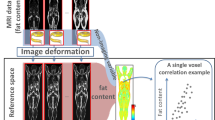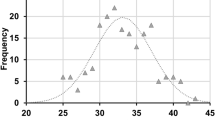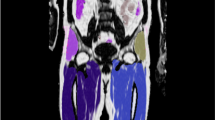Abstract
Introduction:
Given the considerable time and research cost of analyzing biomedical images to quantify adipose tissue volumes, automated image analysis methods are highly desirable. Hippo Fat™ is a new software program designed to automatically quantify adipose tissue areas from magnetic resonance images without user inputs. Hippo Fat™ has yet to be independently validated against commonly used image analysis software programs.
Objective:
Our aim was to compare estimates of VAT (visceral adipose tissue) and SAT (subcutaneous adipose tissue) using the new Hippo Fat™ software against those from a widely used, validated, computer-assisted manual method (slice-O-matic version 4.2, Tomovision, Montreal, CA, USA) to assess its potential utility for large-scale studies.
Methods:
A Siemens Magnetom Vision 1.5-T whole-body scanner and a T1-weighted fast-spin echo pulse sequence were used to collect multiple, contiguous axial images of the abdomen from a sample of 40 healthy adults (20 men) aged 18–77 years of age, with mean body mass index of 29 kg/m2 (range=19–43 kg/m2).
Results:
Hippo Fat™ provided estimates of VAT and SAT that were highly correlated with estimates using slice-O-matic (R2>0.9). Average VAT was 9.4% lower and average SAT was 3.7% higher using Hippo Fat™ compared to slice-O-matic; the overestimation of SAT tended to be greater among individuals with greater adiposity. Individual-level differences for VAT were also substantial; Hippo Fat™ gave estimates of VAT ranging from 1184 cm3 less to 566 cm3 more than estimates for the same person using slice-O-matic.
Conclusion:
Hippo Fat™ provides a rapid method of quantifying total VAT, although the method does not provide estimates that are interchangeable with slice-O-matic at either the group (mean) or individual level.
This is a preview of subscription content, access via your institution
Access options
Subscribe to this journal
Receive 12 print issues and online access
$259.00 per year
only $21.58 per issue
Buy this article
- Purchase on Springer Link
- Instant access to full article PDF
Prices may be subject to local taxes which are calculated during checkout




Similar content being viewed by others
References
Rebuffe-Scrive M, Lonnrothe P, Marin P, Wesslau C, Bjorntorp P, Smith U . Regional adipose tissue metabolism in men and postmenopausal women. Int J Obes Relat Metab Disord 1987; 11: 347–355.
Reaven G . Role of insulin resistance in human disease. Diabetes 1988; 37: 1595–1607.
Pouliot MC, Despres JP, Nadeau A, Moorjani S, Prud'Homme D, Lupien PJ et al. Visceral obesity in men. Associations with glucose tolerance, plasma insulin, and lipoprotein levels. Diabetes 1992; 41: 826–834.
Kissebah A . Intra-abdominal fat: is it a major factor in developing diabetes and coronary artery disease? Diabetes Res Clin Pract 1996; 30: 25–30.
Despres J . The insulin resistance–dyslipidemic syndrome of visceral obesity: effect on patients' risk. Obes Res 1998; 6: 8S–17S.
Reaven G . Syndrome X: 10 years after. Drugs 1999; 58: 19–20; (discussion 75–82).
Bjorntorp P . Metabolic difference between visceral fat and subcutaneous abdominal fat. Diabetes Metab 2000; 26 (Suppl 3): 10–12.
Montague C, O'Rahilly S . The perils of portliness: causes and consequences of visceral adiposity. Diabetes 2000; 49: 883–888.
Wajchenberg BL . Subcutaneous and visceral adipose tissue: their relation to the metabolic syndrome. Endocr Rev 2000; 21: 697–738.
Wajchenberg BL, Giannella-Neto D, da Silva ME, Santos RF . Depot-specific hormonal characteristics of subcutaneous and visceral adipose tissue and their relation to the metabolic syndrome. Horm Metab Res 2002; 34: 616–621.
Depres J-P, Golay A, Sjostrom L, for the Rimonabant in Obesity-Lipids Study Group. Effects of Rimonabant on metabolic risk factors in overweight patients with dyslipidemia. N Engl J Med 2005; 353: 2121–2134.
Schwartz T, Nihalani N, Virk S, Jindal S, Chilton M . Psychiatric medication-induced obesity: treatment options. Obes Rev 2004; 5: 233–238.
Ross R . Advances in the application of imaging methods in applied and clinical physiology. Acta Diabetol 2003; 40 (Suppl 1): S45–S50.
Krssak M, Petersen K, Dresner A, DiPietro L, Vogel S, Rothman D et al. Intramyocellular lipid concentrations are correlated with insulin sensitivity in humans: a 1H- NMR spectroscopy study. Diabetologia 1999; 42: 113–116.
Seppala-Lindroos A, Vehkavaara S, Hakkinen A, Goto T, Westerbacka J, Sovijarvi A et al. Fat accumulation in the liver is associated with defects in insulin suppression of glucose production and serum free fatty acids independant of obesity in normal men. J Clin Endocrinol Metab 2002; 87: 3023–3028.
Fowler PA, Fuller MF, Glasbey CA, Foster MA, Cameron GG, McNeill G et al. Total and subcutaneous adipose tissue in women: the measurement of distribution and accurate prediction of quantity by using magnetic resonance imaging. Am J Clin Nutr 1991; 54: 18–25.
Abate N, Burns D, Peshock RM, Garg A, Grundy SM . Estimation of adipose tissue mass by magnetic resonance imaging: validation against dissection in human cadavers. J Lipid Res 1994; 35: 1490–1496.
Positano V, Gastaldelli A, Sironi AM, Santarelli MF, Lombardi M, Landini L . An accurate and robust method for unsupervised assessment of abdominal fat by MRI. J Magn Reson Imaging 2004; 20: 684–689.
Positano V (2004) Hippo Fat. CNR Institute of Clinical Physiology: Pisa, Italy.
Lancaster JL, Ghiatas AA, Alyassin A, Kilcoyne RF, Bonora E, DeFronzo RA . Measurement of abdominal fat with T1-weighted MR images. J Magn Reson Imaging 1991; 1: 363–369.
Ross R, Leger L, Guardo R, De Guise J, Pike BG . Adipose tissue volume measured by magnetic resonance imaging and computerized tomography in rats. J Appl Physiol 1991; 70: 2164–2172.
Ross R, Leger L, Morris D, de Guise J, Guardo R . Quantification of adipose tissue by MRI: relationship with anthropometric variables. J Appl Physiol 1992; 72: 787–795.
Heymsfield SB, Nunez C, Testolin C, Gallagher D . Anthropometry and methods of body composition measurement for research and field application in the elderly. Eur J Clin Nutr 2000; 54 (Suppl 3): S26–S32.
Park YW, Allison DB, Heymsfield SB, Gallagher D . Larger amounts of visceral adipose tissue in Asian Americans. Obes Res 2001; 9: 381–387.
Janssen I, Heymsfield SB, Allison DB, Kotler DP, Ross R . Body mass index and waist circumference independently contribute to the prediction of nonabdominal, abdominal subcutaneous, and visceral fat. Am J Clin Nutr 2002; 75: 683–688.
Slentz CA, Aiken LB, Houmard JA, Bales CW, Johnson JL, Tanner CJ et al. Inactivity, exercise, and visceral fat. STRRIDE: a randomized, controlled study of exercise intensity and amount. J Appl Physiol 2005; 99: 1613–1618.
Mitsiopoulos N, Baumgartner RN, Heymsfield SB, Lyons W, Gallagher D, Ross R . Cadaver validation of skeletal muscle measurement by magnetic resonance imaging and computerized tomography. J Appl Physiol 1998; 85: 115–122.
Kim J, Wang Z, Heymsfield SB, Baumgartner RN, Gallagher D . Total-body skeletal muscle mass: estimation by a new dual-energy X-ray absorptiometry method. Am J Clin Nutr 2002; 76: 378–383.
Potretzke AM, Schmitz KH, Jensen MD . Preventing overestimation of pixels in computed tomography assessment of visceral fat. Obes Res 2004; 12: 1698–1701.
Janssen I, Heymsfield SB, Baumgartner RN, Ross R . Estimation of skeletal muscle mass by bioelectrical impedance analysis. J Appl Physiol 2000; 89: 465–471.
Udapa J, Samarasekera S . Fuzzy connectedness and object definition: theory, algorithm and application in image segmentation. Graph Models Image Process 1996; 58: 246–261.
Janssen I, Heymsfield SB, Ross R . Application of simple anthropometry in the assessment of health risk: implications for the Canadian physical activity, fitness and lifestyle appraisal. Can J Appl Physiol 2002; 27: 396–414.
Lee S, Janssen I, Ross R . Interindividual variation in abdominal subcutaneous and visceral adipose tissue: influence of measurement site. J Appl Physiol 2004; 97: 948–954.
Shen W, Punyanitya M, Wang Z, Gallagher D, St-Onge M-P, Albu J et al. Total body skeletal muscle and adipose tissue volumes: estimation from a single abdominal cross-sectional image. J Appl Physiol 2004; 97: 2333–2338.
Shen W, Punyanitya M, Wang Z, Gallagher D, St-Onge M-P, Albu J et al. Visceral adipose tissue: relations between single-slice areas and total volume. Am J Clin Nutr 2004; 80: 271–278.
Kelley D, Thaete F, Troost F, Huwe T, Goodpaster B . Subdivisions of subcutaneous abdominal adipose tissue and insulin resistance. Am J Physiol Endocrinol Metab 2000; 278: E941–948.
Smith S, Lovejoy J, Greenway F, Ryan D, de Jonge L, de la Bretonne J et al. Contributions of total body fat, abdominal subcutaneous adipose tissue compartments, and visceral adipose tissue to the metabolic complications of obesity. Metab Clin Exp 2001; 50: 425–435.
Iacobellis G, Assael F, Ribaudo MC, Zappaterreno A, Alessi G, Di Mario U et al. Epicardial fat from echocardiography: a new method for visceral adipose tissue prediction. Obes Res 2003; 11: 304–310.
Shen W, Wang Z, Punyanita M, Lei J, Sinav A, Kral JG et al. Adipose tissue quantification by imaging methods: a proposed classification. Obes Res 2003; 11: 5–16.
Acknowledgements
This work was supported by Grants HD12252 and DK064870 from the National Institutes of Health, Bethesda, MA, USA.
Author information
Authors and Affiliations
Corresponding author
Rights and permissions
About this article
Cite this article
Demerath, E., Ritter, K., Couch, W. et al. Validity of a new automated software program for visceral adipose tissue estimation. Int J Obes 31, 285–291 (2007). https://doi.org/10.1038/sj.ijo.0803409
Received:
Revised:
Accepted:
Published:
Issue Date:
DOI: https://doi.org/10.1038/sj.ijo.0803409
Keywords
This article is cited by
-
CoreSlicer: a web toolkit for analytic morphomics
BMC Medical Imaging (2019)
-
Reliability and validity of the new VikingSlice software for computed tomography body composition analysis
European Journal of Clinical Nutrition (2019)
-
Bone Marrow Adipose Tissue Quantification by Imaging
Current Osteoporosis Reports (2019)
-
Marrow Adipose Tissue in Older Men: Association with Visceral and Subcutaneous Fat, Bone Volume, Metabolism, and Inflammation
Calcified Tissue International (2018)
-
Relationships between fatty infiltration in the thigh and calf in women with knee osteoarthritis
Aging Clinical and Experimental Research (2017)



